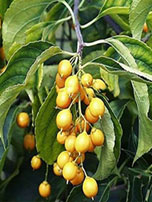SHAHEED KARTAR SINGH SARABHA AYURVEDIC MEDICAL COLLEGE & HOSPITAL
Affiliated to Guru Ravidas Ayurved University, Hoshiarpur Punjab
Affiliated to Guru Ravidas Ayurved University, Hoshiarpur Punjab

Botanical Name : Celastrus paniculatus Willd.
Family : Celastraceae
Introduction :
This drug considered as medya, rasayana , mangment of sidgma kustha & bhagandara. It mentioned in vedic literature . It is seen that intelligence promoting drugs are usually agnivardhak.
It is seen that intelligence promoting drugs are usually agnivardhak and this agni is sadhakagni. (Sadhak is one of the types of pitta). A person of pitta prakruti has sharp agni. He/she feels more thirsty and more hungry. Pitta prakruti people are intelligent.
Names in different Indian languages :
English : Staff tree, Intellect tree
Hindi : Malkangani
Kannada : kariganne
Malayalam : Paluruvam, cheru punna
Sanskrit : Jyothismati, pitataila
Tamil : Valulavai
Telugu : Danti cettu, gundumida
Unani : Malkkangani
Synonyms :
Paaraavatpadi. Kangunikaa, Kanguni, Vegaa, Maalkaanguni, Svarnalatikaa, Kaakaandaki, Katuveekaa
Classification according to Charaka, Susrutha & Vagbhata :
Charaka
Sirovirecana
Susrutha
Arkädi, Adhobhãgahara, Sirovirecana
Vagbhata
Arkãdi
Varieties & adulterants – (CV – controversy, AD – adulterants) :
1. Alavana
2. Salavanã
3. Rakta Phanha
4. Raktaphala.
5. Kãkãdani(Kãkamardanikã) – Cardiospermum helicacabum Linn.
6. Tejovati— Zanthoxylum budrunga wall.
Morphology :
It is a climbing or scrambling shrub, the young shoots and branches pendulous.
Leaves—glabrous, broadly ovate or obovate, acuminate or acute.
Flowers—unisexual, yellowish-green, borne in terminal, pendulous panicles.
Fruit— capsule, globose, 3-valved, 3-celled, 3-6 seeded.
Seeds are enclosed in complete red, ovoid, brown. (Flowers throughout the year).
Distribution & Habitat :
Tropical and subtropical Himalayas upto 1500m (Punjab to Assam) & Bihar and South India
Chemical constituents :
celastrine and paniculatine
Root-bark & stem— pristimerin
Seeds— celapagine, celapanigine, celapanine, celastrol, celastrine, paniculatine,malkanguniol, malkangunin, paniculatadiol, 1-amyrin, beta—sitosterol; acetic, benzoic, formic, linoleic acids etc.
Properties :
Rasa: Katu, Tikta
Guna: Tiksna
Virya: Ushna
Vipãka: Katu
Karma : Kapha-vätahara, Dipana, Medhya, Rasãyana, nervine and brain tonic, diaphoretic, febrifugal, emetic.
Indications :
Kustha, Vatavyadhi, Udara, Gulma
mental depression, hysteria , memory; also used for scabies, eczema, wounds, rheumatic pains, paralysis.
Dosage :
Powder 3-5 g. oil 5-15 drops
Part Used :
whole plant
Internal use :
Nervous System : Improves memory , enhances grasping power. Cow’s ghee and jyotishmati oil mixture is used as a memory enhancer.
Digestive System : Appetizer, Snigdha and ushna gunas improve peristalsis and are therefore useful in overcoming constipation and abdominal distension (flatulence).
Circulatory System : cardio tonic. improves cardiac output. Therefore useful in bradycardia and oedema, Black oil of jyotishmati is useful in breathlessness; yellow oil is used in osteoarthritis (external use).
Respiratory system : It is used for nasya also useful in asthma and bronchitis.
Urinary System : increase renal circulation ,it acts as a diuretic.
Reproductive System : Aphrodisiac. It is used in infertility (impotency).
Skin : Diaphoretic and cures skin disorders. It is used as antipyretic.
Temperature : diaphoretic, it is used as antipyretic. Within 3-4 hrs. it reduces fever by promoting sweating.
Important Yogas :
Jyotismati tailm.
Important research work going on :
1. skin diseases
2. antispermatogenic effect
Therapeutic Uses :
(1) Artava ksaya: Consumption of Jyotismati leaves (fried) along with Kanjika relieves amenorrhoea (C.D.).
(2) Sidhma: Jyotismati oil processed with Apamarga ksãra jala for 7 times may be applied locally (A.H.Ci.19).
(3) Udara: Jyotismati oil, Sarjaksãra and Hingu should be taken with milk (S.S.Ci.14).
